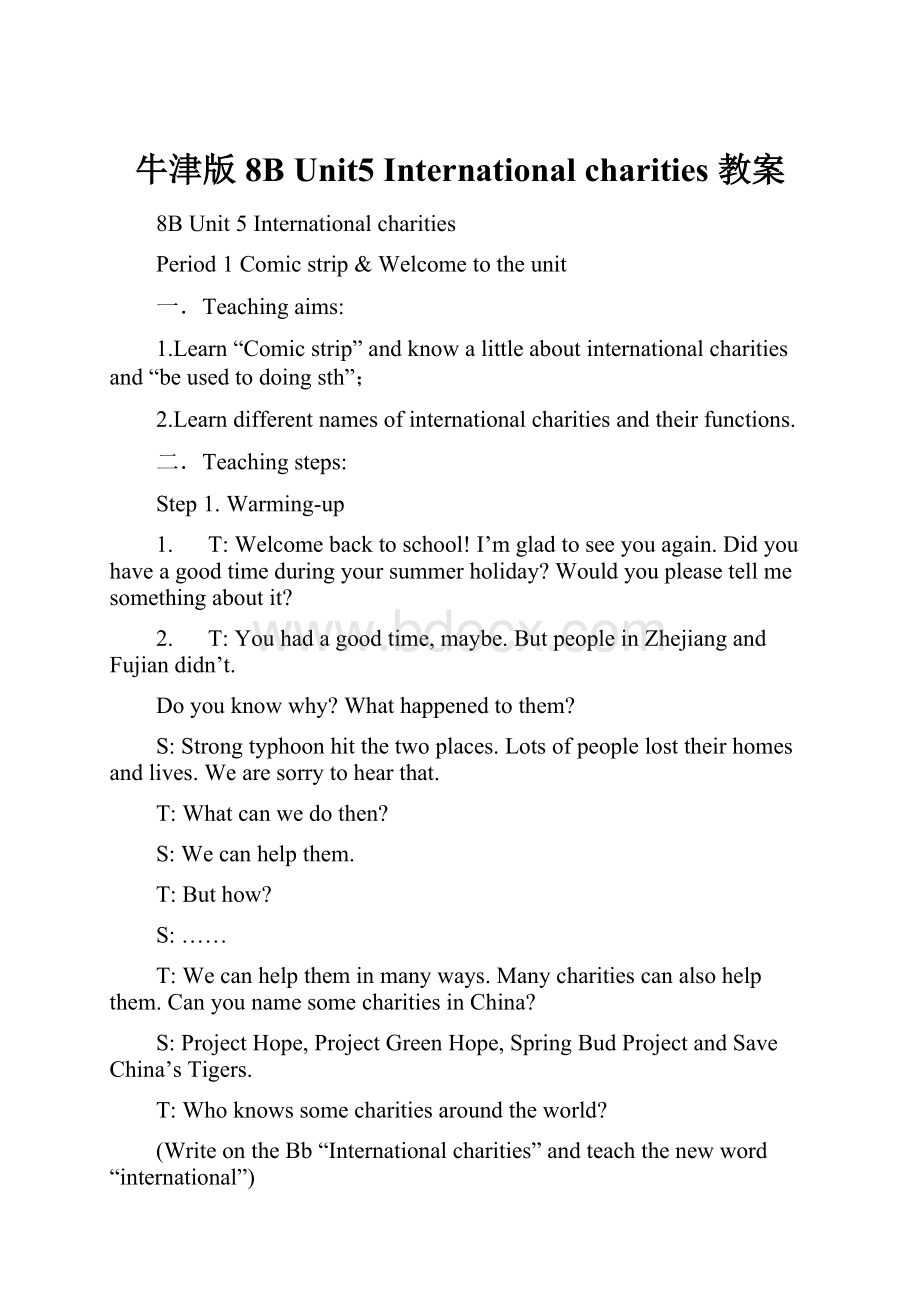牛津版8B Unit5 International charities 教案.docx
《牛津版8B Unit5 International charities 教案.docx》由会员分享,可在线阅读,更多相关《牛津版8B Unit5 International charities 教案.docx(34页珍藏版)》请在冰豆网上搜索。

牛津版8BUnit5Internationalcharities教案
8BUnit5Internationalcharities
Period1Comicstrip&Welcometotheunit
一.Teachingaims:
1.Learn“Comicstrip”andknowalittleaboutinternationalcharitiesand“beusedtodoingsth”;
2.Learndifferentnamesofinternationalcharitiesandtheirfunctions.
二.Teachingsteps:
Step1.Warming-up
1. T:
Welcomebacktoschool!
I’mgladtoseeyouagain.Didyouhaveagoodtimeduringyoursummerholiday?
Wouldyoupleasetellmesomethingaboutit?
2. T:
Youhadagoodtime,maybe.ButpeopleinZhejiangandFujiandidn’t.
Doyouknowwhy?
Whathappenedtothem?
S:
Strongtyphoonhitthetwoplaces.Lotsofpeoplelosttheirhomesandlives.Wearesorrytohearthat.
T:
Whatcanwedothen?
S:
Wecanhelpthem.
T:
Buthow?
S:
……
T:
Wecanhelptheminmanyways.Manycharitiescanalsohelpthem.CanyounamesomecharitiesinChina?
S:
ProjectHope,ProjectGreenHope,SpringBudProjectandSaveChina’sTigers.
T:
Whoknowssomecharitiesaroundtheworld?
(WriteontheBb“Internationalcharities”andteachthenewword“international”)
eg.一个国际会议/机场/时装秀/篮球比赛
Step2Presentation
1.Showthewallchartandpresentsomecharitiesintheworld:
a. ORBIS奥比斯
Note:
It’sacharitylikeaflyingeyehospital.Ifpeopleinpoorcountrieshaveeyeproblemsandtheyhavenomoneytoseethedoctor,volunteerdoctorswilloperateonthemonaplane.
b. Oxfam乐施会
Note:
It’saBritishcharitythathelpspeopleinmanyways.
c. UNICEF联合国儿童基金会
Note:
It’sacharitythathelpschildreninneed.
d. WorldVision世界宣明会
Note:
It’saChristian(基督教的)charity.
e. WWF=WorldWideFundforNature世界自然基金会
Note:
It’sacharitythatprotectswildlifeandnature.
2.Practisereadingthemagainandagain.
3.P75(PartA)
Step3Discussion
1.T:
Asweknow,peopleinpoorareasneedalotofthings.Whatdotheyneed?
(GettheSstodiscuss)
2.P75PartBT:
Whatdotheyneedmost/least?
3.GettheSstomakeareportlikethis:
Ithinktheyneed…most/least.
Step4.Presentation
1. Presentsomenewvocabulary:
a. pocketn.口袋
pocketmoney零花钱
T:
Ioftengivemysonanddaughtersomepocketmoney.Whodoyougetpocketmoneyfrom?
Howmuchpocketmoneydoyougeteveryweek?
b. usedtodosth.过去常常,以前常常
T:
Iusedtogivemysononlyoneyuanashispocketmoney,butnowIgivehimtwoyuan.
Eg.过去常常帮助别人/过去曾当过主持人/过去曾住在农村/过去不喜欢音乐
c. beusedtodoingsth.
lookforwardtodoingsth.
T:
Ilikewalking.I’musedtowalkingaftersupper.
Eddielikeseatingmeat.Heisusedtoeatingmeat.
Myhusbandisverylazy.Heisusedtogettinguplate.
eg.习惯于生活在城里/习惯于早起/习惯于讲英语/习惯于喝果汁
d. healthcare医疗
T:
Ithinkpeopleinpoorareashavenomoneytoseedoctors.Theyneedhealthcare.
Step5Comicstrip
1. ShowtheSsthewallchart
T:
WhatdoyouthinkofEddieandHobo?
(GettheSstospeakfreely.)
2. T:
IthinkHoboisnotonlycleverbutalsokind.Heisgoingtodosomethingkind.ListentotheconversationbetweenEddieandHoboandfindout:
a. WhatisHobogoingtodo?
b. Whattimeisitnow?
c. WhatdoesEddiewanttodofirst?
d. Wherewilltheygo?
3. Booksopen!
GettheSstoraisesomedifficulty.
a. left留下,剩下
eg.我还剩下10元。
/还剩下一点儿时间。
/什么也没留下。
b. afterwards后来
first---then---afterwards---finally
c. bekindtosb.对某人友好
It’s/That’skindofyou.你真好。
eg.对某人有礼貌/无理/大方
d. too…to…太…而不能
I’mtooweaktowalk.
=I’msoweakthatIcan’twalk.=I’mnotstrongenoughtowalk.
eg.难以理解/冷得无法游泳/生病了吃不下东西
e. takeyoutoarestaurant带你去一家饭店
eg.带我去颐和园/带我们去火星/带她回家/带他们去那里
f. nextto靠近,贴近,隔壁
eg.在我家隔壁/靠海/在他旁边/靠近无锡
4. Readafterthetapeandpractisereading,thenactitout.
Step6Welcometotheunit
1.Tintroducesbackgroundinformation:
Therearemanyinternationalcharitieshelpingneedypeopleandworthy
causesallovertheworld.LookatsomesymbolsinPartA.Tusesthese
symbolstopresentthefollowing charities.Tputsthepictureswith
thesesymbolsontheblackboard.
2.Talkaboutinternationalcharitiesandtheworktheydo.AskSs
Whichinternationalcharitiestheyknowandwritealistontheboard.
3.TellSsTolookatthesymbolsinPartAandthenamesofthe
charitiesinthebox.Askthemtowritethenamesofthecharitiesunder
thepictures.Tellthemtotrytodothetaskontheirownfirst,then
compareanswerswithapartner.
4.Checkanswersasaclass.ThenSsHowmuchtheyknowaboutwhatthe
charitiesinPartAdoandhowtheyhelppeople.
5.Talkaboutwhatlifeislikeforpeoplewhoareverypoor.AskSs
to
thinkabouthowtheirlivesmightbedifferentiftheyhadalmostno
money.
6.Dividetheclassintopairs.AskSstolookatthelistofitemsin
PartBanddecidewhichitemsarethemostimportantandwhichitemsare
theleastimportantforpeopleinpoorcountries.
Step7.Langagepoints.
1.Wecanhaveabiglunchafterwards.过后我们可以大吃一顿。
▶一日三餐之前一般不加冠词。
如:
Wheredidyouhavebreakfastthismorning?
你今天在哪里吃早饭的?
▶但如果breakfast,lunch,supper或dinner之前有形容词修饰时,常加a/an。
如:
Wehadawonderfuldinnerlastnight.昨晚我们吃了一顿丰盛的晚餐。
2.I’mtooweaktowalk.我体力太弱了,没法再走了。
▶“too…to…”结构表示“太…而不能…”,副词后接形容词或副词的原形,其后再接动词不定式。
如:
Sheistooyoungtogotoschool.她年纪太小了不能去上学。
▶但是当句子的主语与不定式的主语不一致时,常需在不定式前补加一个介词短语forsb.,即:
too…forsb.todosth.。
如:
Theproblemistoodifficultformetoworkout.
▶“too…to…”结构可以转化为“so…that…”结构,如:
Heistooshorttoreachtheapple.→
Heissoshortthathecan’treachtheapple.
3. Completethefollowingpassage:
HobohearsthatOxfamn______money.HewantstodonateEddie’sp______moneytoOxfam.ButEddiewantstohavelunchf_____becauseit’s12o’clock.Heisn’tusedtog_______outbeforelunch.Hepretends(假装)thatheistoow_____towalk.Finally,Hobod____totakehimtoanewr________nexttotheOxfamshop.
Step8.Homework
达标情况:
Maybethestudentsdon’tknowtheaccuratetaskofeachinternationalcharity,theteachercangivethemasmuchinformationaspossible.Thestudentsshouldnotknowtheaccuratetaskofeachinternationalcharity,justknowthemaintaskandthenameofthecharity.
Period2-3Reading
Teachingaims:
1.Understandopenquestionsusedinaninterview.
2.Infergeneralmeaningfromtitleandcontext.
3.Predictthemeaningsofspecificwordsfromclosecontext
4.Checkunderstandingbylinkingpartsofsentences.
5.Summarizeinformationbycompletingnotes.
Teachingprocedures:
PartA:
Step1AskifSs.Knowanyonewhoworksforacharity,andifso,whichcharityandwhattheydo.
Step2Twrites“ORBIS”ontheblackboard.AskSswhattheyknowaboutORBISorwhethertheyhaveheardofitbeforedoingtheWelcometotheunitexercise.Talkaboutblindnessandhowitmightaffectaperson’slife.
Step3Listentothetapeaboutthereading,andthenaskSstoreadthetextbythemselvesagain.
Step4AskSssomequestionstochecktheirunderstandingandencouragests.tothinkmoreaboutthetopic.
Step5AskSstodopairwork.TheypracticetheinterviewandperformDrMaandtheinterviewer.(Threeorfourpairsperformtheinterview.)
Step6AskSstofindoutthelanguagepointsintheconversationandanalyzethem.
PartB:
Step1RemindSsthatthevocabularylistedinPartB1appearsintheinterviewonpages76and77.IfSsarenotsurewhatawordmeans,itmayhelpthemtoreadthewordincontextonthosepages.
Step2TellSstoworkontheirowntocompletePartB1.
Step3AskfiveSstoeachreadoutonewordanditsdefinition.TellSstochecktheirownanswers.
Step4TellSstoreadtheinterviewonpages76and77again,andusetheinformationtheretohelpthemcompletePartB2.
Step5TasksonestudenttoreadoutAmy’sarticle,pausingattheblanks.ThisstudentaskstheotherSsforthecorrectwordstocompletesentences.
PartC:
Step1.ExplainthecontextofPartC1.AmyislookingattheORBISwebsiteandmakingnotes.
Step2.Sts.readAmy’snotesandmatchthefirsthalvesofthesentencesontheleftwiththesecondhalvesontherightbyputtingthecorrectlettersinblanks.
Step3.Checkanswersasaclass.AsksixSstoreadoutonecompletesentenceeach.WritethecorrectsequenceoflettersontheboardsoSscanchecktheiranswers.
Step4.AskSstoreadDaniel’snotesinPartC2throughfirstforoverallmeaningbeforetheydotheexercise.
Step5.AskSstocompleteDaniel’snotesbyselectingthecorrectwordsfromthewordsinbrackets.
Step6.WhenSts.havefinishedPartC2,askvolunteerstoreadoutonesentenceeach.
Step7.Languagepoints.
1.Blindnessaffectsabout45millionpeoplearoundtheworlds,mostlyinpoorcountries.
失眠影响着全球4500万人,大部分在贫穷国家。
affect在这里的意思是“影响”。
如:
Smokingaffectsyourhealth.吸烟影响健康。
Mostly意思是“主要地”、“大部分”,注意和most的区别。
如:
Theboysinourclassmostlylikesinging.我们班上的男孩子大部分喜欢唱歌。
Mostoftheboysinourclasslikeplayingfootball.
我们班上大多数男孩子喜欢踢足球。
2.Thegoodnewsisthat80percentofthecasesofblindnesscanbecuredorprevented.
好消息是80%的失明病例是能治疗或预防的。
这是由that引导的表语从句,如:
Thebadnewsisthatmanypeopledonothavethemoneyformedicaltreatment.
坏消息是很多人没钱进行医疗诊治。
cure这里是“治愈”、“治疗”的意思。
如:
Themedicinecuredmycold.这药治好了我的感冒。
3.Bytraininglocaldoctorsandnurses,wehopetohelpmorepeople.
通过培训当地的医生和护士,我们希望能帮助更多的人。
by这里的意思是“通过(某中途径)”,后接动词-ing形式。
如:
(1)Byhelpingeachother,thestudentshaveimprovedtheirgrades.
通过互相帮助,学生们提高了学习成绩。
(2)WehopepeoplewillsupportourworkbysendingdonationstoORBIS.
我们希望人们通过向奥比斯捐助支持我们的工作。
4.I’mproudthatIcanhelpsomanypeople.
proud后既可跟that引导的宾语从句又可跟不定式或介词of引起的短语。
如:
I’mproudtobeyourfriend.成为你的朋友我很骄傲。
Hele